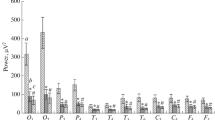Abstract
The development of the resonance EEG responses of the left and right occipital areas was studied in right-handed men during prolonged (12 or 120 s) rhythmic, photostimulation with the intensity of 0.7 J and frequencies of 6, 10, and 16 Hz. Analysis of the EEG fine spectral structure was applied to compare the accumulated baseline EEG spectra and EEG spectra during photostimulation, to observe the dynamics of the short-term spectra and to detect power changes in the EEG narrow spectral band sharply coincident with the stimulation frequency. The more pronounced EEG responses to photostimulation were observed in subjects with the initially low EEG baseline, α-rhythm. Two-minute flash trains produced a substantial increase in the EEG power within the stimulation frequency with superposed oscillatory processes with different periods. These fluctuations are considered a reflection of intricate interaction between the adaptive and resonance EEG responses to the presented intermittent stimulation. Under 12-s stimulation the resonance EEG responses are steadily recorded within the first 3 s of stimulation and immediately after the flash cessation EEG power at the stimulation frequency returns to the initial level. The resonance EEG responses were more pronounced in the right hemisphere than in the left one, especially, at the stimulation frequencies of 6 and 16 Hz. With increasing the stimulation frequency, the maximum of resonance EEG responses was reached earlier. Under the stimulation frequency of 6 Hz, the maximal response was recorded 9–12 s after the beginning of flashes, at the frequencies of 10 and 16 Hz, it was recorded within 3–6 and 3 s, respectively.
Similar content being viewed by others
References
Fedotchev, A.I. and Bondar’, A.T., Human EEG Responses to Intermittent Light Stimulation with Different Frequencies,Usp. Fiziol. Nauk, 1990, vol. 21, no. 1, p. 97.
Danilova, N.N.,Funktsional’nye sostoyaniya: mekhanizmy i diagnostika (Functional States: Mechanisms and Diagnostics), Moscow: Mosk. Gos. Univ., 1985.
Pervushin, Yu.V., The Resonance Mechanisms of Change in Biological States,Biofizika, 1991, vol. 36, no. 3, p. 534.
Makeev, V.M., Stochastic Resonance and Its Possible Role in the Living Nature,Biofizika, 1993, vol. 38, no. 1, p. 194.
Fedotchev, A.I., Analysis of the Resonance EEG Reactions during Estimation of the Efficiency of Sensory Stimulation,Fiziol. Chel., 1997, vol. 23, no. 4, p. 117.
Garkavi, L.Kh., Kvakina, E.B., and Ukolova, M.A.,Adaptatsionnye reaktsii i rezistentnost' organizma (Adaptive Reactions and the Organism's Resistance), Rostov-on-Don: Rost. Gos. Univ., 1990.
Bekhtereva, N.P. and Medvedev, V.I., The Prospects of Human Physiology Development,Usp. Fiziol. Nauk, 1989, vol. 20, no. 1, p. 28.
Novikov, V.S., Immunophysiological Mechanisms of Adaptation to Extreme Factors,Fiziol. Chel., 1996, vol. 22, no. 2, p. 25.
Garkavi, L.Kh., Kvakina, E.B., Shikhlyarova, A.I.,et al., Magnetic Fields, Adaptive Reactions, and Self-Organization of the Living Systems,Biofizika, 1996, vol. 41, no. 4, p. 898.
Zubkova, S.M., Adaptive Changes in the Organism during the Action of Electromagnetic Radiation,Biofizika, 1996, vol. 41, no. 4, p. 906.
Bogolyubov, V.M. and Zubkova, S.M., The Ways of Optimization of Parameters of Physiotherapeutic Procedures,Vopr. Kurortol., Fizioter. Lech., 1998, no. 2, p. 3.
Sviderskaya, N.E., Korol’kova, T.A., and Tishaninova, L.V., Fields of Increased Activity: Electrophysiological Correlates,Zh. Vyssh. Nervn. Deyat. im. I.P. Pavlova, 1993, vol. 43, no. 6, p. 1080.
Farber, D.A. and Vil’davskii, V.Yu., Heterogeneity and Age Dynamics of α-Rhythm of the Electroencephalogram,Fiziol. Chel., 1996, vol. 22, no. 5, p. 5.
Basar-Eroglu, C., Basar, E., Demiralp, T.,et al., P300-Response: Possible Psychophysiological Correlates in Delta and Theta Channels,Int. J. Psychophysiol., 1992, vol. 13, no. 2, p. 161.
Kawaguchi, T. Jijiwa, H., and Watanabe, S., The Dynamics of Phase Relationships of Alpha Waves during Photic Driving,EEG Clin. Neurophysiol., 1993, vol. 87, no. 1, p. 88.
Sakamoto, H., Inouye, T., and Shinosaki, K., Preservation of Alpha Rhythm Shortly after Photic Driving,Int. J. Neurosci., 1993, vol. 73, nos. 3–4, p. 227.
Politoff, A.L., Monson, N., Stadter, R.P., and Hass, P., Severity of Dementia Correlates with Loss of Broad-Band Visual Cortical Responses,Dementia, 1995, vol. 6, no. 3, p. 169.
Bondar', A.T., Fedotchev, A.I., and Konovalov, V.F., Resonance Phenomena in EEG during Photostimulation with Changing Frequency of Flashes. Communication I. Analysis of Photostimulation Effects,Fiziol. Chel., 1989, vol. 15, no. 1, p. 3.
Fedotchev, A.I., Bondar', A.T., and Konovalov, V.F., Resonance Phenomena in EEG during Photostimulation with Changing Frequency of Flashes. Communication II. Regional Features of the Resonance Effects,Fiziol. Chel., 1989, vol. 15, no. 4, p. 3.
Fedotchev, A.I. and Bondar', A.T., Nonspecific Mechanisms of the CNS Adaptation to Intermittent Stimuli, EEG Spectral Structure, and Optimal Parameters of Rhythmical Sensory Stimulation,Usp. Fiziol. Nauk, 1996, vol. 27, no. 4, p. 44.
Novak, P., Lepicovska, V., and Dostalek, C., Periodic Amplitude Modulation of EEG,Neurosci. Lett., 1992, vol. 136, no. 2, p. 213.
Achermann, P. and Borbely, A.A., Low-frequency (<1 Hz) Oscillations in the Human Sleep EEG,Neuroscience, 1997, vol. 81, no. 1, p. 213.
Amzica, F. and Steriade, M., The K-Complex: Its Slow (<1 Hz) Rhythmicity and Relation to Delta Waves,Neurol., 1997, vol. 49, no. 4, p. 952.
Novak, P., Novak, V., Li, Z., and Remillard, G., Time-frequency Analysis of Slow Cortical Activity and Cardiovascular Fluctuations in a Case of Alzheimer's Disease,Clin. Auton. Res., 1994, vol. 4, no. 3, p. 141.
Frolov, M.V., Mekhedova, A.Ya., and Milovanova, G.B., Detection of Superslow Oscillations of Brain Potentials: Technique and Results,Fiziol. Chel., 1997, vol. 23, no. 4, p. 127.
Narici, L., Pizzella, V., Romani, G.L.,et al., Evoked alpha- and mu-Rhythm in Humans: a Neuromagnetic Study,Brain Res., 1990, vol. 520, nos. 1–2, p. 222.
Author information
Authors and Affiliations
Rights and permissions
About this article
Cite this article
Fedotchev, A.I., Bondar’, A.T. & Akoev, I.G. Dynamic characteristics of the human resonance EEG responses to rhythmic photostimulation. Hum Physiol 26, 179–186 (2000). https://doi.org/10.1007/BF02760089
Received:
Issue Date:
DOI: https://doi.org/10.1007/BF02760089




